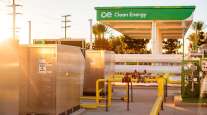Truck Stop Executives See Growing Acceptance of Natural Gas

ARLINGTON, Va. — The emergence of natural gas as a viable fuel for the commercial trucking industry is a matter of when — and not if — issues such as a cost-effective fuel supply network, a new generation of engines and driver acceptance are overcome, industry experts said here Thursday.
“The big question is timing,” said James Haslam, chairman and CEO of truck stop chain Pilot Flying J, speaking on a panel at American Trucking Associations’ Summit on Natural Gas in Trucking here. The session, “Infrastructure Hurdles: The Chicken or the Egg,” was moderated by ATA President Bill Graves.
“The energy boom is the single greatest thing the country has going for it. We have to take advantage of this. The best place to do it is with trucks. We believe we will have the infrastructure in place to take care of your needs,” Haslam said.
Pilot Flying J is backing up that view by building a natural-gas fueling network in partnership with Clean Energy Fuels Corp. The current plan is to have 70 locations equipped by the end of 2012 and 150 by the end of next year.
“Natural gas is a very viable option over the long term.” said Thomas O’Brien, CEO of TravelCenters of America, “Natural gas in over-the-road applications is in its infancy — it doesn’t really exist. The demand today from customers frankly is not sufficient to start this on my own,” O’Brien said.
That fact prompted TA to create a natural gas supply partnership with Shell Oil to develop 100 fueling stations at TA truck stops.
“We are in tests as an industry,” said Frank Love, president of operations for Love’s Travel Stops. “A year from now we will see the availability of those engines. They will have to be priced with a comparably equipped diesel engine. They are not there today, but they will be in the future. “
Love said that his company is entering the natural-gas market with a focus on compressed natural gas for regional hauls. He cited the importance of creating a heavier-duty engine as a key factor to advancing natural gas fueling.
In addition, Love added that fueling facilities will have to be equipped to fill tanks as quickly with compressed natural gas as they do with diesel, noting the reputation of CNG as a fuel can take 45 minutes to fill. By comparison, diesel can be filled in seven to 10 minutes.
Love’s solved that problem by creating a fast-fill station that delivers CNG at the same speed as a diesel tractor can be filled.
Making the natural gas fueling experience driver-friendly also is important, Haslam said. He noted that the natural gas fueling process was similar to diesel except for the need to wear gloves and goggles.
O’Brien said that while driver acceptance could be difficult, the fleets will be the ones making the investment that ultimately will require the drivers to adapt.
Asked about when natural gas would gain commercial acceptance in trucking, O’Brien cited a study that projected a 7% market share for those engines in five years.
Haslam didn’t give a timeframe, but said the market would evolve based on engine availability and the future price differential between natural gas and diesel fuel.




